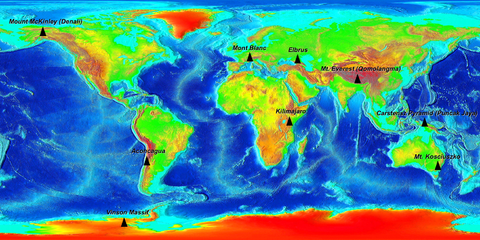Quiapo – Procession of the Black Nazarene
Date: 9th January
The procession, and the accompanying Feast of the Black Nazarene, takes place every year on 9th January. It is usually the single largest festival of the year in the Philippines and thousands of devotees come to the district of Quiapo to take part in the procession to commemorates the transfer of the Black Nazarene image (“traslacion”) from Intramuros to Quiapo Church.
Date: 3rd Sunday of January
The Ati-Atihan Festival is a feast held in honor of the Santo Niño held annually in January concluding on third Sunday, in the town of
Kalibo, Aklan in the Philippines. It is the wildest among Philippine fiestas and considered as the Mother of All Philippine festivals. Celebrants paint their faces with black soot and wear bright, outlandish costumes as they dance in revelry during the last three days of this two week-long festival. Catholics and non-Catholics alike observe this special day with processions, parades, dancing, and merrymaking.
Sinulog
Date: 3rd Sunday of January
The Sinulog is an annual festival held on the third Sunday of January in
Cebu City, Philippines. The festival honors the child Jesus, known as the Santo Niño (Holy Child), patron of the city of Cebu. It is a dance ritual that commemorates the Cebuano people’s pagan origin, and their acceptance of Christianity. The festival features a street parade with participants in bright-colored costumes dancing to the rhythm of drums, trumpets, and native gongs.
Dinagyang
Date: 4th Sunday of January
The Dinagyang is a religious and cultural festival in
Iloilo City, Philippines held on the fourth Sunday of January. It is held both to honor the Santo Niño and to celebrate the arrival on Panay of Malay settlers and the subsequent selling of the island to them by the Atis. Dinagyang was voted as the best Tourism Event for 2006, 2007 and 2008 by the Association of Tourism Officers in the Philippines.
Panagbenga
Date: February
Panagbenga is month-long annual flower festival occurring in
Baguio. The festival, held during the month of February, was created as a tribute to the city’s flowers and as a way to rise up from the devastation of the 1990 Luzon earthquake. The festival includes floats that are decorated with flowers unlike those used in Pasadena’s Rose Parade. The festival also includes street dancing, presented by dancers clad in flower-inspired costumes, that is inspired by the Bendian, an Ibaloi dance of celebration that came from the Cordillera region.
Kaamulan
Date: 28th Feb – 1st March
The Kaamulan Festival is a Bukidnon ethnic-cultural festival that takes place from the last week of February to the first week of March. Kaamulan, from the Binukid word amul, “to gather”, is an indigenous Bukidnon term for a gathering for any purpose. It can mean a datukship ritual, a wedding ceremony, a thanksgiving festival during harvest time, a peace pact, or any number of these together. The Festival is held in Malaybalay City from the second half of February to March 10, the anniversary date of the foundation of Bukidnon as a province in 1917,d to celebrate the culture and tradition of the seven ethnic tribal groups—Bukidnon, Higaonon, Talaandig, Manobo, Matigsalug, Tigwahanon and Umayamnon—that originally inhabited the province. It is the only ethnic festival in the Philippines.
Moriones
Date: Holy Week
The Moriones is an annual festival held on Holy Week on the island of Marinduque, Philippines. The “Moriones” are men and women in costumes and masks replicating the garb of biblical Roman soldiers as interpreted by local folks – Morion means “mask” or “visor,” a part of the medieval Roman armor which covers the face. The Moriones or Moryonan tradition has inspired the creation of other festivals in the Philippines where cultural practices or folk history is turned into street festivals.
Date: Good Friday
Every year on Good Friday or the Friday before Easter a dozen or so penitents – mostly men but with the occasional woman – are taken to a rice field in the barrio of San Pedro Cutud, 3km (2 miles) from the proper of City of San Fernando,
Pampanga and nailed to a cross using two-inch (5 cm) stainless steel nails that have been soaked in alcohol to disinfect them. The penitents are taken down when they feel cleansed of their sin. Other penitents flagellate themselves using bamboo sticks tied to a rope.
Turumba
Date: Between April and May
Every year during the months of April and may, the people of Pakil, in the province of Laguna celebrates the Turumba Festival. It commemorates the seven sorrows of the Blessed Virgin Mary. It is held 7 times each year between the months of April and May. The first is held on the Friday before Palm Sunday and the last falls on Pentecost Sunday.
Flores de Mayo
Date: 1st May – 31st May
Flores de Mayo is a Catholic festival held in the Philippines in the month of May. It lasts for a month, and is held in honor of the Virgin Mary. The Santa Cruzan is a parade held on the last day of Flores de Mayo in honor of Reyna Elena.
Santacruzan
Date: 31st May
Santacruzan is the queen of Maytime festivals. It is a novena procession, in commemoration of Saint Helena’s finding of the cross. Saint Helena was the mother of Constantine the Great. The procession, however, differs from other religious processions in that it does not parade the usual images of patron saints. Instead, biblical and historical characters are represented by the local people dressed in appropriate costumes.
Carabao
Date: 14th May – 15th May
Begining May 14th, the people of Pulilan in Bulacan Province, San Isidro in Nueva Ecija Province, and Angono in Rizal Province celebrate for two days. On the first day, farmers pay pay homage to the beast of burden which is the farmer’s best friend – the lowly carabao. These animals are very important for farmers because they help till the land. Farmers brush their carabaos’ skin until it is sleek and shiny. Then the carabaos are decorated with ribbons and attached to carts. In the afternoon, farmers lead their carabaos to the church square to be part of the procession. At the church, the carabaos kneel for their blessings. On the second day, the carabaos compete in a friendly race.
Date: 15th May
Lucban celebrates the Pahiyas Festival in honor of the patron saint of farmers, St. Isidore. This festival showcases a street of houses which are adorned with fruits, vegetables, agricultural products, handicrafts and kiping, a rice-made decoration, which afterwards can be eaten grilled or fried. The houses are judged and the best one is proclaimed the winner.
Obando Fertility Rites
Date: 17th May – 19th May
“Santa Clarang pinong-pino, Ang pangako ko ay ganito, Pagdating ko sa Obando, Sasayaw ako ng pandanggo.” The Obando Fertility Rites are a Filipino dance ritual. Every year during the month of May, to the tune of musical instruments made out of bamboo materials, the men, women and children of Obando, Bulacan, Philippines wear traditional dance costumes to dance on the streets followed by the images of their patron saints San Pascual Baylon (St. Paschal), Santa Clara (St. Clare) and Nuestra Señora de Salambao (Our Lady of Salambao), while singing the song Santa Clara Pinung-Pino. The feast days or dance festivals are held for three consecutive days: May 17 for St. Paschal, May 18 for St. Claire and May 19 for the Our Lady of Salambaw. What makes the Obando fiesta unique among Philippine festivals is the dance performed in the streets by the childless women.
Pintados
Date: 29th June
The Pintados-Kasadyaan Festival is a merry-making event lasting a whole month, highlights of which include the
Leyte Kasadyaan Festival of Festivals, the Pintados Festival Ritual Dance Presentation and the Pagrayhak Grand Parade. These festivals are said to have begun from the feast day of Señor Santo Niño, held every June 29th. The Leyteños celebrate a religious festival in a unique and colorful way. Since the Visayans are experienced in the art of body tattooing, men and women are fond of tattooing themselves.
Kadayawan
Date: Third week of August
The Kadayawan Festival is an annual festival in the
city of Davao in the Philippines. Its name derives from the friendly greeting “Madayaw”, from the Dabawenyo word “dayaw”, meaning good, valuable, superior or beautiful. The festival is a celebration of life, a thanksgiving for the gifts of nature, the wealth of culture, the bounties of harvest and serenity of living.
Penafrancia Fluvial
Date: Third Saturday and Sunday of September
The Peñafrancia Festival in Naga City, Camarines Sur, Bicol Region. During the festivities, people attend church services, followed by parades on the streets, fireworks, and feasting. The ninth day, usually falling on the third Saturday of September, is marked by a fluvial procession. The image of the Virgin Mary is carried on a barge which is trailed by thousands of devotees in boats gliding alongside. People who line the river banks shout “Viva la Virgen! as the Virgin passes by.

Peñafrancia Fluvial Festival
MassKara
Date: 3rd weekend nearest to 19th October
The MassKara Festival is a week-long festival held each year in Bacolod City, the capital of Negros Occidental province. The festival features a street dance competition where people from all walks of life troop to the streets to see colorfully-masked dancers gyrating to the rhythm of Latin musical beats in a display of mastery, gaiety, coordination and stamina. The word MassKara has a double meaning. First, it is a fusion of the English word “mass” or many and “kara”, the Spanish word for “face.” MassKara then becomes a “mass of faces,” and these faces have to be smiling to project Bacolod already known in the late 70′s as the City of Smiles.

MassKara Festival
Date: 25th October
Each year there is a Lanzones (a small grape-sized tropical fruit) Festival held in October. The week-long festival is one of the more colorful events in the Philippines. The Lanzones festival is celebrating its 30th Anniversary on October 2009.
Higantes
Date: 23rd November
Angono celebrates the “Higantes Festival” which coincides with the Feast of Saint Clement, the Patron Saint of Angono. Higantes Festival is now promoted as tourism-generating event in the country. This attracts numerous tourist from all over the world. The higantes are made of paper-mache. Higantes measures four to five feet in diameter and ten to twelve feet in height. Traditionally, it began in the last century when Angono was a Spanish hacienda. This higantes was influenced by the Mexican art form of paper-mache brought by the Spanish priests to the Philippines.
Read more on Higantes Festival
Date: December – Saturday before Christmas Eve
The Giant Lanterns Festival is an annual festival held in December (Saturday before Christmas Eve) in the
City of San Fernando in the Philippines. The festival features a competition of giant lanterns. Because of the popularity of the festival, the city has been nicknamed the “Christmas Capital of the Philippines”.

Giant Lanterns Festival
Misa de Gallo
Date: 16th December – 25th December
Traditionally, Christmas Day in the Philippines is ushered in by the nine-day dawn masses that start on December 16. Known as the Misa de Gallo (Rooster’s Mass) in the traditional Spanish and in Filipino as Simbang Gabi, or “Night Mass”, this novena of Masses is the most important Filipino Christmas tradition.
 With the slogan "you press the button, we do the rest," George Eastman put the first simple camera into the hands of a world of consumers in 1888. In so doing, he made a cumbersome and complicated process easy to use and accessible to nearly everyone.
With the slogan "you press the button, we do the rest," George Eastman put the first simple camera into the hands of a world of consumers in 1888. In so doing, he made a cumbersome and complicated process easy to use and accessible to nearly everyone.






















